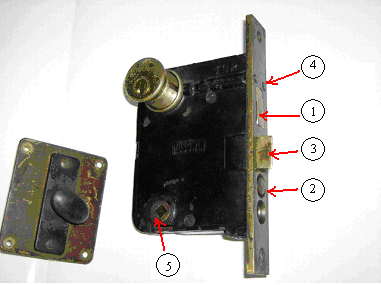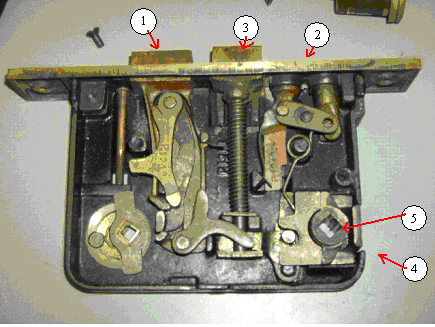Dad D. sent me a beautiful story regarding his trials and tribulations surrounding his exploration of the anatomy of a Mortise Lock. It’s an awesome story and a brilliant mechanical device. Enjoy!
“The Mortise Falconâ€
My jaw was clenched on that dark and stormy morning as I stumbled out of that small local church that I called my own. This was not the cathedral that inspires the soul to leap but a quiet, yet pleasant, rustic building where very few parishioners were left from a once mighty congregation. Oh yes, there had been hundreds, but that was centennials ago.
Why the clenched jaw? I had another assignment! There is a rule among those that “do†that 10% of the crowd does the work and 90% come along for the ride. Well, when typical attendance is 12, 10% is not a whole lot of people. And when the average age of an aging church is 92, if you‘re under 60, you’re it!
My assignment? “The door knob had been ripped off a back door, could I fix it?†There had been a theater group that had used the church; and unfortunately, when they could not get the back door open, they applied significant leverage and the door knob exploded into their hands. An emergency exit for the church had been murdered, and as Sam would say to Bridgid, ”When a man’s partner is killed, he’s supposed to do something about it.”
The church is well over 100 years old. There had been a fire around 1930. We should assume that this door mechanism was at least that old. There is no question that I expected an adventure and the discovery of a mechanical marvel that would rival any “figurine of gold and encrusted with jewels.” With trusty multi-blade screw driver in hand, I began to remove the Mortise lock.
The trick to removing the mortise lock is to remove all inside and outside handles, remove the screws that hold the mechanism into the door mortise (hole in the door jam), and most importantly, remove the cylinder that contains the key coding – this cylinder simply unscrews once the long set screw on the face plate of the mortise is removed.
I chose to do this myself since the church does not have a lot of money. As Sam would say, “to keep family troubles in the family.” Sure, it would have been easy to get a locksmith to come over and fix it, but the web clearly suggested that a replacement mortise lock would be as much as $500 for an antique replacement and locksmith labor is a premium cost since they are always busy getting car doors open when electronic or mechanical keys are left inside.
So once the Mortise lock is removed, this is what it looks like.
The Mortise Lock controls the deadbolt (#1), the override buttons (#2), the latch (#3), the thumb clip (#4) exterior handle, the inside door knob (#5), and the key access (top left corner).
There’s the lock cylinder which unscrews (the image above shows in screwed back in).
This is a lot for a 6†by 3†by 1†antique mechanism to do.
Immediately, being minimally versed in high tech communication systems, I began to look on the web for instructions, hints, or exploded views. And there was not much. So whatever I found had to be posted on the web to close this information hole! The name on the Mortise Lock was RUSSWIN and it was inscribed with “P1213â€. I found the RUSSWIN company (now Corbin-RUSSWIN) and wrote an email. The answer: “Sorry, we don’t carry information nor parts for something that old.”
So I took it apart! And this is what it looks like:
(1) Deadbolt and Deadbolt thumb Knob Socket
(2) Override Buttons
(3) Latch
(4) Outside Thumb clip*
(5) Inside door knob socket
After I took out each precision mechanical part, the case looks like this.
Balloon 1 points to the Murder Victim – a broken cast pin.
And then I found the problem, the pin (identified in the above jpg) had broken off so all motion from the knob was no longer rotating the adjacent mechanism but simply sliding it to the left in the picture. The pin was a few thousandths more than ¼ inch. A standard size! The inner diameter of the brass pieces that surrounded that pin were 10 thousandths wider – perfect ! All I needed was a new ¼ inch replacement pin.
Not thinking that I would even try to weld this, I found a threaded standoff, cut it to 3/8â€, drilled a hole where the old pin had been and screwed in the new pin with a new brass screw from the bottom. ($0.70). The new knob $8.00.
Success! Now all I have to do is hang this Mortise lock back into place with hope that my new pin would work and would last.
And as Sam Spade said to the guilty murderer:
”I hope they don’t hang you, precious, by that sweet neck… The chances are you’ll get off with life. That means if you’re a good girl, you’ll be out in 20 years. I’ll be waiting for you. If they hang you, I’ll always remember you.”
And now that I know what a Mortise Lock looks like, I will be ready to replace the pin again after 20 years to life.
*Thumb Clip isn’t the best description for the device. When you push that with your thumb, the button pushes a bar that hits this little clip . The clip transfers the motion to push the latch open bar which needs to rotate around that pin that broke.
Thanks Dad D! Awesome exploratory look into the depths of the Mortise Lock.


